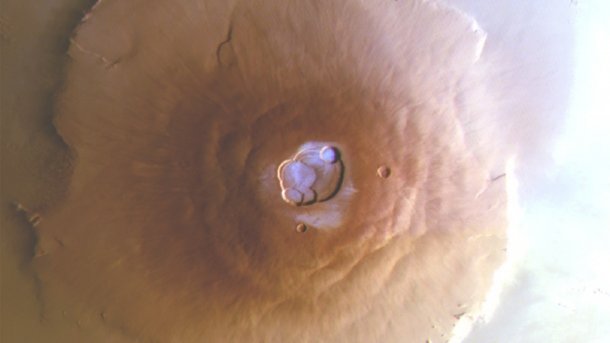On Olympus Mons: there is also water ice on the surface of the Martian equator
So far, frost has only been found on the surface of Mars at the poles, but early in the morning some appears far away. The discovery is a surprise.

The thin layer of frost on the Olympus Mons
(Image: ESA/DLR/FU Berlin)
In tens of thousands of satellite images from ESA's Mars orbiter TGO, an international research group has discovered a periodically recurring layer of ice on the highest volcanoes in the solar system in the Tharsis region of Mars. The extremely thin frost on the mountain peaks, which only appears for a few hours in the morning, is thus much closer to the equator than was previously thought possible. According to study leader Adomas Valantinas from Brown University, this may be the last remnants of a former climate cycle that included precipitation and possibly even snowfall on the extremely high volcanoes.
Further research needed
Before the discovery was made, over 30,000 satellite images of the Red Planet were analyzed, the team explains. They searched for the relevant images. These showed that the frost appears on the surface for a few hours in the morning before disappearing in the sunlight. This is unexpected because the mixture of a lot of sun and a thin atmosphere actually ensures comparatively high temperatures even at these altitudes. The fact that there is still ice there was therefore a surprise. However, with a thickness of one hundredth of a millimetre, the frost is extremely thin. Because it is distributed over an extremely large area, 150,000 tons of water are exchanged between the surface and the atmosphere every day during the cold season.
The periodic frost layer was found on the volcanoes of the so-called Tharsis region to the west of the Valles Marineris rift system. There are several high stratovolcanoes there, three of which lie in a striking row. Further west lies Olympus Mons, the highest mountain and largest volcano in the solar system. The work on the frost on its peak, which has now been published in the journal Nature Geoscience, makes it clear that it still holds surprises despite decades of research. Further analyses of the frost should now help to answer even more questions about the Red Planet, such as where there is still water and in what form.
(mho)